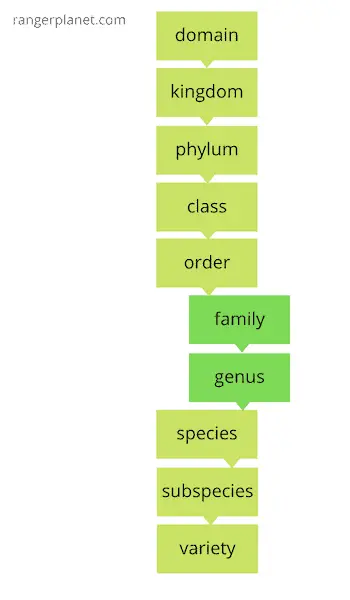You may have heard the terms genus and family, but what’s the difference? Well, here I’ll explain the differences between genus vs family. In logical terms, you would probably look upon it more as Family vs Genus, for reasons that should become clearer.
More on the details shortly, let’s start with a quick summary.
In basic taxonomical terms, the genus is a further division of the family. Family can in fact have divisions in between, such as subfamily, and tribe before genus. But all organisms in the genus category will be derived from the family of organisms in a hierarchical representation.
Let’s go on to explain that both genus and family are both a part of the biological classification system (Taxonomy), categorizing all living things.
Genus and daily are part of taxonomy
Taxonomy is the methodology – a standard of hierarchy for the arrangement and organization of organisms. It is about incorporating evolutionary, historical, characteristic, and adaptation information into a taxonomical hierarchy for easier understanding.
Difference between genus vs family

Terms such as family and genus help simplify the sorting of organisms into taxonomy into a broad sense – so that everyone can grasp a picture of related knowledge.
“Carl Linnaeus” is the one who proposed and developed the systematic classifications of organisms into the taxonomical hierarchy we know and use today.
The significant difference between genus and family is the taxonomic (ordering) rankings used for the biological classification of organisms based on their characteristics and phylogenetic relationships.
In simple hierarchical terms, the genus is commonly one position above species and one below family among the core taxonomic ranks in the biological category.
Here’s a simple example chart to help better comprehend the concept:
Still not clear with the idea, let’s start with breaking down the two areas, starting with genus…
What is a genus?
Genus is one of the most prominent aspects of the taxonomy of organisms. Genus can be described as a group of organisms having similar traits, qualities, or features.
The plural of genus is “genera”. Genus is used as the “first name” of a scientific name in the binomial nomenclature classification system.
Genus has these essential pillars: Monophyl (shared derived characteristics), compactness, and distinctiveness. To make it clearer these terms let’s see it this way:
- Monophyl: grouping of all ancestral taxon descendants together (phylogenetic unit should be demonstrated carefully).
- Compactness: should be reasonably compact without over-expansion.
- Distinctiveness: should be distinctive regarding evolutionary criteria, including ecology, morphology, and DNA sequences.
Examples of genus vs family:
Like Leo (lion), Tigris (Tiger), Pardus (Leopard) are different species from a genus-Panthera.
Let’s look at some examples in taxonomy:
| Examples | Humans | Cats |
|---|---|---|
| Scientific name | H sapiens | Felis catus |
| Kingdom: | Animalia | Animalia |
| Phylum: | Chordata | Chordata |
| Class: | Mammalia | Mammalia |
| Order: | Primates | Carnivora |
| Family: | Hominidae | Felidae |
| Genus: | Homo | Felis |
| Specie: | sapiens | f.catus |
Here’s a further way of describing an example…
Example: Sunflower
Scientific name (Binomial name): Helianthus annuus
Kingdom: Plantae
Order: AsteralesSunflower
> Family: Asteraceae
> Genus: Helianthus
Species: H.annuus
With the above examples, I hope the concept of the category genus and where it lies in the scale is becoming clearer. Let’s move on to family:
What is a family?
Next to the family, the genus is a further rank in classification. A family is a group of one or more genera. The genera – under a specific “family” share similar factors –
- Attributes
- Traits
- Characteristics
A family is above genus in the taxonomic rankings, therefore it contains a more significant number of organisms than the genus category, and is the pool of organisms upon which the genus is then derived and divided further.
Family is above “genus” and below “order” in taxonomic ranking terms.
A Family can also be described as a group of people descended from a common ancestor or somehow related. It can be described loosely as a tribe and is often broken down into tribes as a further subcategory.
In binomial classification, the name ‘family’ is derived from the generic name. The term “family” was coined by Pierre Magnol.
It is essential to understand that many organisms consist of subfamilies as well. It should be noted that a family name must be derived from the category “genus”, and the genus is a further division of the category “species”. This provides a cascade approach to classifying organisms.
Examples of the family:
Here are a few examples of organisms you will find in a family:
- Lion scientific name Panthera Leo belongs to Family Felidae and subfamily Pantherinae.
- Another elementary example of the family is of Walnuts and hickories. Both are classified as a part of the “Walnut family” when we expand walnut (genus Juglans) and hickories (genus Carya) but together, both fit within the Walnut family.
- The scientific name of Dog is Canis lupus, dogs belong to the family Canidae. The genus is Canis and species Lupus which is similar to the wolf.
- Lily Scientific’s name is Lilium belongs to the family Liliaceae, which consists of 15 genera (the plural).
- Mosquito’s scientific name is Culicidae belongs to the family Culicidae.
Genus vs Family: based on different factors
Ranking in Taxonomy:
According to the binomial classification of organisms, family …or even sub-family ranks above genus.
In contrast, the genus in taxonomical classification ranks below family and above species. After species, the genus is a fundamental and essential unit and level in the systematic classification of organisms. The diversity becomes greater from this point onward.
Arrangement:
A genus category is broader and more encompassing than species, however, a family is even broader than a genus.
Genus ranks below family in the taxonomic hierarchy; therefore, a genus is more precise and less inclusive than a family, as the family breaks down the organisms into their more similar set of characteristics.
For example:

Genus vs family: naming
Genus being lower in rank in the hierarchy than family means that it contains fewer numbers of organisms.
Scientific naming:
A scientific naming procedure called “binomial Nomenclature,” also called “Linnaean Latin,” a naming system for naming organisms.
Every organism is given two names in this hierarchical system, considering its genus as the first name and species as the second name.
Rules for writing the scientific name of an organism include:
- Genus name which first part is often written in capitals and italics
- Specie name, which is the second part, is italicized with a low case letter.
We can take an easy example of our name, consisting of the first name and a surname (second part).
For Example:
Sunflower: Helianthus annuus, helianthus shows “genus” while Annuus shows the “species”.
In contrast with genus, a taxon family is not used to name organisms in binomial Nomenclature.
Family vs genus: to finish
These taxonomies help us to understand and break down in manageable groups the characteristics of organisms.
However, learning and examining scientific terms can be quite tricky. Still, once you understand that the system is designed to help you sensibly group organisms, then you will realize it’s worth learning, or at least understanding, how it works.
This is a delicate, and sometimes confusing, but all-encompassing means of classification, which works as a fundamental way of categorizing all organisms.
I hope this has helped you learn the difference between Genus vs Family in the simplest way so that you can take on board the knowledge and grow from there.
To grow that knowledge, and understand more about how taxonomy is laid out, here are some further related topics:
Difference between variety and species
